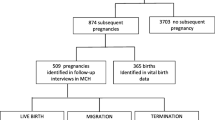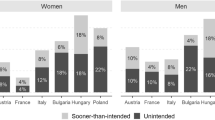Abstract
Australia’s low fertility rate is commonly attributed to deliberate decisions by women to avoid having children. Existing theoretical explanations of fertility decision-making mostly view childbearing as a rational, voluntary process and focus on the ‘costs’ to women of having children. Although this may help explain why women do not have children, it contributes very little to understanding why women do have children. This study describes childbearing desires, expectations and outcomes in a population-based sample of 569 30–34-years-old Australian women recruited from the Australian Electoral Roll in 2005. Most women surveyed wanted to have children, and their childbearing outcomes were associated with biological, psychological and social factors including the lack of a partner and adverse health conditions. The factors and their relative importance varied by parity. Most women had fewer children than they desired, and many would have children, or more children, if their circumstances were different. These data challenge prevailing assumptions about women’s childbearing behaviour that women are able to choose when and if they have a child. Based on the findings, a conceptual framework of childbearing behaviour is proposed which builds on existing theoretical explanations to explain why women do and do not have children, differences by parity, and the role of circumstances in women’s childbearing behaviour. The findings and conceptual framework have implications for public policies, and indicate that multiple approaches are required which are sensitive to and address the barriers women face in family formation.

Similar content being viewed by others
References
Aassve, A., Billari, F. C., & Piccarreta, R. (2007). Strings of adulthood: A sequence analysis of young British women’s work–family trajectories. European Journal of Population, 23(3–4), 369–388.
Ajzen, I. (1985). From intentions to actions: A theory of planned behaviour. In J. Kuhl & J. Beckmann (Eds.), Action control, from cognition to behavior (pp. 11–39). Berlin; New York: Springer.
Australian Bureau of Statistics. (2001). A snapshot of Victoria.
Australian Bureau of Statistics. (2003). Socio-economic indexes for areas (SEIFA) 2001.
Australian Bureau of Statistics. (2007a). 4102.0—Australian social trends, 2007.
Australian Bureau of Statistics. (2007b). 4102.0—Australian social trends, 2007. Recent increases in Australia’s fertility.
Australian Bureau of Statistics. (2007c). Cat. No. 2068.0—2006 Census Tables. 2006 Census of Population and Housing Victoria (State). Religious affiliation by age by sex.
Australian Bureau of Statistics. (2007d). Cat. No. 2068.0—2006 Census Tables. Number of Children ever born by age of female (Victoria—State). 2006 Census of Population and Housing.
Australian Bureau of Statistics. (2008). Births, Australia, 2007. Catalogue No. 3301.0.
Australian Bureau of Statistics. (2009). Births, Australia, 2008. Catalogue No. 3301.0.
Australian Bureau of Statistics (ABS). (2002). General social survey, victoria 2002. Catalogue No. 4159.2.55.001.
Bartlett, M. S. (1954). A note on the multiplying factors for various chi square approximations. Journal of the Royal Statistical Society, 16(Series B), 296–298.
Bartlett, D. J., Marshall, N. S., Williams, A., & Grunstein, R. R. (2008). Sleep health New South Wales: Chronic sleep restriction and daytime sleepiness. Internal Medicine Journal, 38(1), 24–31.
Beckman, L. J., Aizenberg, R., Forsythe, A. B., & Day, T. (1983). A theoretical analysis of antecedents of young couples’ fertility decision and outcomes. Demography, 20(4), 519–533.
Bracks, S. (2003). An outward-looking population policy for Australia. In S. Vizard, H. Martin, & T. Watts (Eds.), Australia’s population challenge (pp. 39–43). Melbourne: Penguin Books.
Briscoe, J. (2004). The baby gamble. The Age, 17 April. pp. 18–26.
Catell, R. (1966). The scree test for number of factors. Multivariate Behavioural Research, 1, 245–276.
Cook, D. (2001). Having children isn’t a rational decision. The Age, 8 March. p. 15.
de Kretser, L. (2002). Women say no to babies. Herald Sun, 5 June. p. 11.
De Vaus, D. (2002). Fertility decline in Australia: A demographic context. Family Matters, 63(Spring-Summer), 14–24.
Department of the Prime Minister and Cabinet. (2008). Families in Australia: 2008. Canberra: Australian Government.
Fisher, K., & Charnock, D. (2003). Partnering and fertility patterns: Analysis of the HILDA survey, wave 1. Paper presented at the HILDA Conference 2003, Melbourne.
Friedman, D., Hechter, M., & Kanazawa, S. (1994). A theory of the value of children. Demography, 31(3), 375–401.
Goldstein, J., Lutz, W., & Testa, M. R. (2003). The emergence of sub-replacement family size ideals in Europe. Population Research and Policy Review, 22(5–6), 479–496.
Gray, M., Qu, L., & Weston, R. (2008). Fertility and family policy in Australia. Research Paper No. 41. Melbourne: Australian Institute of Family Studies.
Green, K. E. (1996). Sociodemographic factors and mail survey response. Psychology and Marketing, 13(2), 171–185.
Hakim, C. (2003). A new approach to explaining fertility patterns: Preference theory. Population and Development Review, 29(3), 349–374.
Hewitt, B., England, P., Baxter, J., & Shafer, E. F. (2010). Education and unintended pregnancies in Australia: Do differences in relationship status and age at birth explain the education gradient? Population Review, 49(1), 36–52.
Hobcraft, J. (2000). Moving beyond elaborate description: Towards understanding choices about parenthood. Paper presented at the fertility and family survey—Flagship conference, Brussels, 29–31 May 2000.
Jain, S. K., & McDonald, P. F. (1997). Fertility of Australian birth cohorts: Components and differentials. Journal of the Australian Population Association, 14(1), 31–46.
Kaiser, H. (1970). A second generation little jiffy. Psychometrika, 35, 401–415.
Kaiser, H. (1974). An index of factorial simplicity. Psychometrika, 39, 31–36.
Lattimore, R., & Pobke, C. (2008). Recent trends in Australian fertility. Canberra: Productivity Commission.
Maher, J.-M., & Dever, M. (2004). What matters to women: Beyond reproductive stereotypes. People and Place, 12(3), 10–17.
Maher, J., Dever, M., Curtin, J., & Singleton, A. (2004). What women (and men) want: Births, policies and choices. Melbourne: School of Political and Social Inquiry, Monash University.
Marie Stopes International. (2008). Real choices: Women, contraception and unplanned pregnancy. http://www.mariestopes-px.rtrk.com.au/contents/Real%20Choices%20-%20Key%20Findings.pdf. Accessed September 2009.
Marks, G. N. (2009). The social effects of the Australian higher education contribution scheme (HECS). Higher Education, 57, 71–84.
McDonald, P. (2000a). Gender equity, social institutions and the future of fertility. Journal of Population Research, 17(1), 1–16.
McDonald, P. (2000b). Low fertility in Australia: Evidence, causes and policy responses. People and Place, 8(2), 6–21.
McDonald, P. (2002). Sustaining fertility through public policy: The range of options. Population (English Edition, 2002), 57(3), 417–446.
McRae, S. (2003). Constraints and choices in mothers’ employment careers: A consideration of Hakim’s preference theory. British Journal of Sociology, 54(3), 317–338.
Miller, W. B. (1994). Childbearing motivations, desires, and intentions: A theoretical framework. Genetic, Social and General Psychology Monographs, 120(2), 223–258.
Miller, W. B., & Pasta, D. J. (1995). Behavioral intentions: Which ones predict fertility behavior in married couples? Journal of Applied Social Psychology, 25(6), 530–555.
Mitchell, D., & Gray, E. (2007). Declining fertility: Intentions, attitudes and aspirations. Journal of Sociology, 43(1), 23–44.
Myers, S. M. (1997). Marital uncertainty and childbearing. Social Forces, 75(4), 1271–1289.
Neal, A. G., & Groat, H. T. (1980). Fertility decision making, unintended births, and the social drift hypothesis: A longitudinal study. Population and Environment, 3(3–4), 221–236.
Parr, N. (2007). Which women stop at one child in Australia? Journal of Population Research, 24(2), 207–225.
Quesnel-Vallée, A., & Morgan, S. P. (2003). Missing the target? Correspondence of fertility intentions and behavior in the U.S. Population Research and Policy Review, 22(5–6), 497–525.
Radecki, S. E., & Beckman, L. J. (1992). Determinants of child-bearing intentions of low-income women: Attitudes versus life circumstances. Journal of Biosocial Science, 24, 157–166.
Read, D., Crockett, J., & Watson, G. (2007). What’s behind recent fertility trends—Government policy, alarms on biological clocks or lessons learned from childhood? People and Place, 15(2), 22–30.
Risse, L. (2006). Does maternity leave encourage higher birth rates? An analysis of the Australian labour force. Australian Journal of Labour Economics, 9(4), 343–370.
Runnion, T. (2001). The behaviour and lifestyle questionnaire—VOCS report submitted to Environment Australia. http://www.deh.gov.au/atmosphere/airquality/publications/report6/pubs/report6-appendices.pdf. Accessed November 2005.
Schoen, R., Astone, N. M., Kim, Y. J., & Nathanson, C. A. (1999). Do fertility intentions affect fertility behaviour? Journal of Marriage and the Family, 61(3), 790–799.
Schoen, R., Kim, Y. J., Nathanson, C. A., Fields, J., & Astone, N. M. (1997). Why do Americans want children? Population and Development Review, 23(2), 333–359.
Smith, A. M. A., Rissel, C., Richters, J., Grulich, A. E., & de Visser, R. O. (2003). Sex in Australia: Reproductive experiences and reproductive health among a representative sample of women. Australian and New Zealand Journal of Public Health, 27(2), 204–209.
Van Peer, C. (2000). Desired and realized fertility in selected FFS-countries. Paper presented at the fertility and family survey—Flagship conference, Brussels, 29–31 May 2000.
Victorian Government Department of Human Services. (2005). Births in Victoria 2003–2004. Victorian Perinatal Data Collection Unit, Melbourne.
Vitali, A., Billari, F. C., Prskawetz, A., & Testa, M. R. (2009). Preference theory and low fertility: A comparative perspective. European Journal of Population, 25(4), 413–438.
Watkins, M. (2001). Monte Carlo PCA for parallel analysis. http://www.personal.psu.edu/mww10/Watkins3.html. Accessed August 2005.
Weisberg, E., Bateson, D., Read, C., Estoesta, J., & Lee, C. (2008). Fertility control?: Middle-aged Australian women’s retrospective reports of their pregnancies. Australian and New Zealand Journal of Public Health, 32(4), 390–392.
Weston, R., & Qu, L. (2004). Dashed hopes? Fertility aspirations and expectations compared. Family Matters, 69(Spring-Summer), 10–18.
Weston, R., Qu, L., Parker, R., & Alexander, M. (2004). ‘It’s not for lack of wanting kids’. A report on the fertility decision making project (No. 11 2004). Melbourne: Australian Institute of Family Studies.
White, L. K., & Kim, H. (1987). The family-building process: Childbearing choices by parity. Journal of Marriage and the Family, 49(2), 271–279.
Yu, P., Kippen, R., & Chapman, B. (2007). Births, debts and mirages: The impact of the higher education contribution scheme (HECS) and other factors on Australian fertility expectations. Journal of Population Research, 24(1), 73–90.
Acknowledgments
A previous version of this paper was presented at the 34th Annual Conference of the Australian Society for Psychosocial Obstetrics and Gynaecology, Adelaide Australia, 1–2 August 2008. The authors are most grateful to the participants who completed the unsolicited postal questionnaire. The first author is the recipient of a Victorian Health Promotion Foundation Public Health PhD Research Scholarship (project number 2004-0694), and received a small grant for this research project from the Population Health Investing in Research Students’ Training Scheme run by the School of Population Health at the University of Melbourne. Assoc. Prof. Ian Gordon and Dr Sandy Clarke from the University of Melbourne’s Statistical Consulting Centre provided statistical advice regarding the sample size determination, principal components analysis and repeated measures ANOVAs.
Author information
Authors and Affiliations
Corresponding author
Appendix
Appendix
Rights and permissions
About this article
Cite this article
Holton, S., Fisher, J. & Rowe, H. To have or not to have? Australian women’s childbearing desires, expectations and outcomes. J Pop Research 28, 353–379 (2011). https://doi.org/10.1007/s12546-011-9072-3
Published:
Issue Date:
DOI: https://doi.org/10.1007/s12546-011-9072-3




